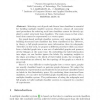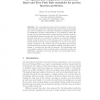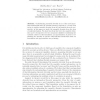113
click to vote
MCS
2010
Springer
15 years 2 months ago
2010
Springer
Abstract. In adversarial classification tasks like spam filtering, intrusion detection in computer networks and biometric authentication, a pattern recognition system must not only...
116
click to vote
MCS
2010
Springer
15 years 2 months ago
2010
Springer
Selecting a set of good and diverse base classifiers is essential for building multiple classifier systems. However, almost all commonly used procedures for selecting such base cla...
113
click to vote
MCS
2010
Springer
15 years 2 months ago
2010
Springer
Abstract. Although widely used to reduce error rates of difficult pattern recognition problems, multiple classifier systems are not in widespread use in off-line signature verifica...
108
click to vote
MCS
2010
Springer
15 years 2 months ago
2010
Springer
Abstract. Classifier decision fusion has been shown to act in a manner analogous to the back-projection of Radon transformations when individual classifier feature sets are non o...
103
click to vote
MCS
2010
Springer
15 years 5 months ago
2010
Springer
We have previously described an incremental learning algorithm, Learn++ .NC, for learning from new datasets that may include new concept classes without accessing previously seen d...
MCS
2010
Springer
15 years 5 months ago
2010
Springer
Abstract. The computational genome-wide annotation of gene functions requires the prediction of hierarchically structured functional classes and can be formalized as a multiclass, ...
110
click to vote
MCS
2010
Springer
15 years 6 months ago
2010
Springer
Abstract. Oza’s Online Boosting algorithm provides a version of AdaBoost which can be trained in an online way for stationary problems. One perspective is that this enables the p...
120
click to vote
MCS
2010
Springer
15 years 7 months ago
2010
Springer
A method for applying weighted decoding to error-correcting output code ensembles of binary classifiers is presented. This method is sensitive to the target class in that a separa...
MCS
2010
Springer
15 years 7 months ago
2010
Springer
Although diversity in classifier ensembles is desirable, its relationship with the ensemble accuracy is not straightforward. Here we derive a decomposition of the majority vote er...
MCS
2010
Springer
15 years 7 months ago
2010
Springer
Abstract. Understanding ensemble diversity is one of the most important fundamental issues in ensemble learning. Inspired by a recent work trying to explain ensemble diversity from...





